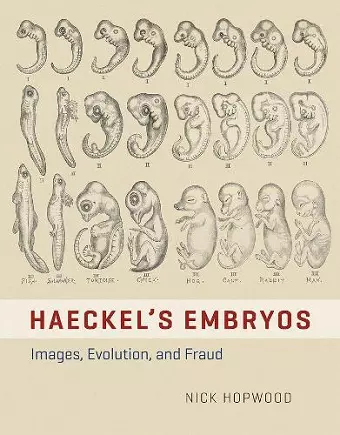HAECKEL'S EMBRYOS - IMAGES, EVOLUTION, AND FRAUD
Format:Hardback
Publisher:The University of Chicago Press
Published:19th May '15
Currently unavailable, our supplier has not provided us a restock date

Pictures from the past powerfully shape current views of the world. In books, television programs, and websites, new images appear alongside others that have survived from decades ago. Among the most famous are drawings of embryos by the Darwinist Ernst Haeckel in which humans and other vertebrates begin identical, then diverge toward their adult forms. But these icons of evolution are notorious, too: within months of their publication in 1868, a colleague alleged fraud, and Haeckel's many enemies have repeated the charge ever since. His embryos nevertheless became a textbook staple until, in 1997, a biologist accused him again, and creationist advocates of intelligent design forced his figures out. How could the most controversial pictures in the history of science have become some of the most widely seen? In Haeckel's Embryos, Nick Hopwood tells this extraordinary story in full for the first time. He tracks the drawings and the charges against them from their genesis in the nineteenth century to their continuing involvement in innovation in the present day, and from Germany to Britain to the United States.Emphasizing the changes worked by circulation and copying, interpretation and debate, Hopwood uses the case to explore how pictures succeed and fail, gain acceptance and spark controversy. Along the way, he reveals how embryonic development was made a process that we can see, compare, and discuss, and how copying - usually dismissed as unoriginal - can be creative, contested, and consequential. With a wealth of expertly contextualized illustrations, Haeckel's Embryos recaptures the shocking novelty of pictures that enthralled schoolchildren and outraged priests, and highlights the remarkable ways these images kept on shaping knowledge as they aged.
"Sumptuous... Hopwood's excellent, thought-provoking book makes us ponder how these erroneous illustrations acquired their iconic status, and, above all, it shines a spotlight on the power of drawings to influence our thinking." - New Scientist; "Rarely have images proved so incendiary as the embryo drawings of nineteenth-century experimental zoologist Ernst Haeckel. In this lavishly illustrated volume, Hopwood traces the chequered history of the sketches, which showed similarities between embryos of higher and lower vertebrates, including humans, at particular points in their development. Haeckel intended the images as support for Charles Darwin's evolutionary theory, but under attack revealed that they were schematics. Hopwood meticulously charts how, despite the controversy, the drawings took on a life of their own." - Nature; "This book is fun to read, chock-full of exhaustive detail made palatable by entertaining turns of phrase, word pictures, and puns... I found myself fully engaged and repeatedly chuckling over Hopwood's wordsmithery. Then, on practically every page, I was forced to loiter and savor the beauty of the historical plates and images. Through it all, I learned so much. Haeckel's Embryos is a wonderful book." - American Biology Teacher; "Detailed, well documented, and rich with illustrations. It is likely to be of most value to those with interests in developmental biology, embryology, the history of attacks on evolution, or the history of scientific publication." - Library Journal; "Hopwood raises important questions (particularly pertinent to the modern era of viral memes) about the teaching of empirical science and the bringing of complex scientific ideas to the public, the 'boundary of popular literature and specialist work,' the relationship between the observer as accurate reporter and as artist, and the line beyond which schematization for didactic or rhetorical effect becomes deliberately misleading." - Publishers Weekly; "Through eighteen chapters of beautifully illustrated text, Hopwood lays out the unfolding landscape of scientific, social, and political factors that led Haeckel to create his images for public consumption, as well as the rounds of debates that have dogged these images since their first appearance in print... Hopwood does a good job of giving his reader a glimpse into the manufacture of Haeckel's images, and in so doing, gives a fresh perspective on the controversy surrounding Haeckel's famous embryos." - Studies in History and Philosophy of Biological and Biomedical Sciences; "Ernst Haeckel, the best known German Darwinist of his day, was also the most controversial. For nearly a century and a half his widely circulated series of animal and human embryos, illustrating common descent, have prompted charges of forgery and fraud from scientific, religious, and political critics. Antievolutionists, especially advocates of intelligent design, have been among his most outspoken detractors. One can only hope that Hopwood's scrupulously researched and evenhandedly argued book will finally lay these longstanding controversies to rest." - Ronald L. Numbers, author of Galileo Goes to Jail and Other Myths about Science and Religion
ISBN: 9780226046945
Dimensions: 28mm x 23mm x 3mm
Weight: 1899g
392 pages